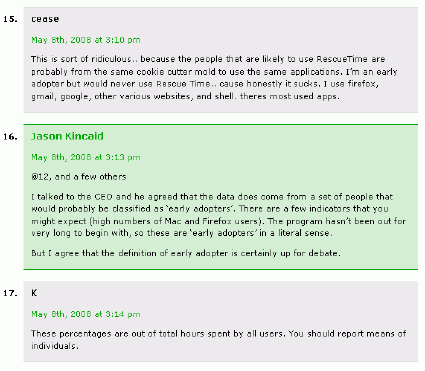I posted a link on our Twitter account a few days back about Jim Brady from the Washington Post’s call for commenters on newspaper websites to post using their real names. In doing away with anonymous commenting, he is hoping to improve the generally low level of discourse you find on many media sites. Here is his justification:
I think part of the problem is that people aren’t held accountable on the Web. People say things online they would never say when disagreeing with someone at the dinner table. I think heated debate is fine, but when there are (flame wars), many people won’t take part for fear they will be attacked and bashed over the head with the (Internet-equivalent) of a steel pipe.
I have mixed feelings about this. On the one hand, I think there is a tradition of respecting anonymity on the Internet that has value, and I am generally opposed to putting up barriers that hinder discussion. On the other hand, the comment sections on many newspaper website are completely broken and I think Brady’s solution would probably work.
Anyway, the whole issue got me thinking about steps I think media companies should take to improve their comments sections, short of requiring people to post using their real names. Below are my ideas based on my experience in trying to manage active comments areas for a variety of clients (we don’t have a comment problem on our own site so we haven’t taken a lot of these steps here):
(1) Have moderators (or other staff) maintain an active presence in the comments
The sites with the worst comments in my experience are those where staffers don’t participate themselves. Having staff post their own comments regularly and lead discussion will go a long way towards improving the level of discourse. From a technical perspective, I think it is a good idea to clearly mark comments by staffers clearly so people know. Techcrunch does this to good effect. In the example below the staffer comment is clearly marked in green.

(2) Force users to have one pre-approved comment before they can post freely
Typically you can tell right off the bat whether a user is going to spew hate and bile or contribute to the conversation. Many sites employ a system where a moderator approves the first comment made by a user can post comments freely.
(3) Filter out the profanity
It seems like every site would do this, but they don’t. They should. Plus, you’ll have a great time developing the list of curse words to filter out.
(4) Report Comment feature
Implement a simple feature on your site that allows your users to report objectionable comments to you. Let your users help police themselves.
(5) Bury/Promote Comments
Along similar lines, allow your readers to vote comments on your site up or down. Automatically hide comments that receive a large number of negative votes. While this can lead to a bit of a mob mentality, it can also effectively hide comments that are completely out of line. It also makes it easy for readers to skim comments and just pick out the good stuff. Digg is an example of a site that uses this with pretty good results.

(6) Require users to register before posting comments
Lots of sites (including ours) simply ask for your name (or pseudonym) and an email address in order to post comments. This is a user friendly approach and leads to lots of comments, but it also leads to drive by comments posted by users who aren’t a part of your site’s community. By putting up some barriers to commenting (such as the creation of a site account), you will weed out people
(7) Enable threaded comments
Using discussion threads to allow users to reply directly to specific comments can improve the flow of the discussion and make things more cohesive.
(8) Give users ability to ignore other commenters
Twitter and some message board software allows individual users to block commenters they find annoying or offensive. After blocking, they never have to see that users comments again. This is a good way to empower your users to block out the noise on their own.
(9) Implement a comment policy
Having a prominent comments policy that clearly explains how your comment system works and sets expectations for behavior can help improve behavior and provide rationale when moderators remove comments and ban users.
So what am I missing? What other tactics can help improve the level of discourse in comments sections?
Sign up today to have our latest posts delivered straight to your inbox.